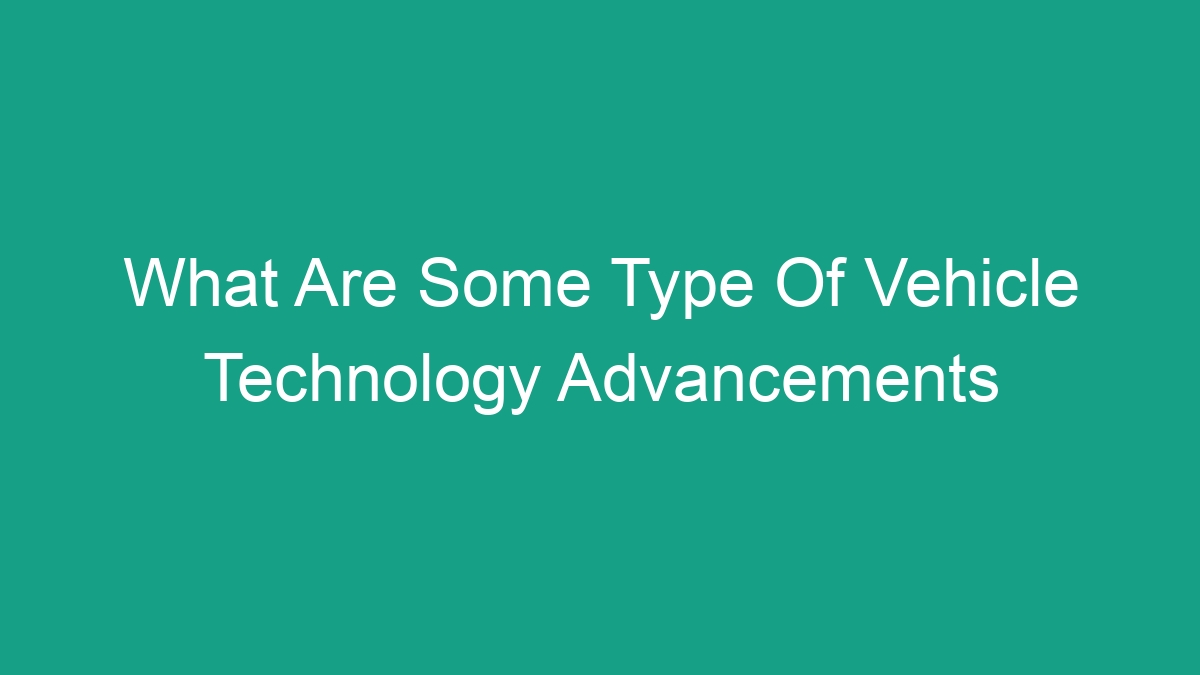
As technology continues to advance, the automotive industry is no exception. From self-driving cars to electric vehicles, there have been numerous technological advancements in the world of vehicles. These advancements have not only improved the safety and efficiency of vehicles but have also had a significant impact on the environment. In this article, we will explore some of the most exciting vehicle technology advancements that are shaping the future of transportation.
1. Electric Vehicles (EVs)
The rise of electric vehicles has been one of the most significant advancements in the automotive industry in recent years. Electric vehicles are powered by electric motors and rechargeable battery packs, rather than internal combustion engines. This means they produce zero tailpipe emissions, making them a much more environmentally friendly option compared to traditional gasoline-powered vehicles.
Key advancements in electric vehicle technology include:
- Longer Range: Modern electric vehicles can travel much further on a single charge, with some models boasting ranges of over 300 miles on a full charge.
- Rapid Charging: Improvements in battery technology and charging infrastructure have made it possible to recharge electric vehicles much faster than before, with some models capable of gaining significant range in just a few minutes.
- Cost Reduction: Advances in battery technology have led to a reduction in the cost of electric vehicle batteries, making electric vehicles more affordable for consumers.
2. Autonomous Vehicles
Autonomous vehicles, also known as self-driving cars, are another major technological advancement in the automotive industry. These vehicles are equipped with advanced sensors, cameras, and computing systems that enable them to operate without human intervention. While fully autonomous vehicles are not yet widely available, there have been significant advancements in this area in recent years.
Key advancements in autonomous vehicle technology include:
- Advanced Driver-Assistance Systems (ADAS): Many modern vehicles are equipped with advanced driver-assistance systems that can perform tasks such as lane-keeping, adaptive cruise control, and automated parking.
- Testing and Development: Major automakers and tech companies are investing heavily in the development and testing of fully autonomous vehicles, with some companies conducting extensive real-world testing on public roads.
- Regulatory Frameworks: Governments around the world are working to establish regulations and guidelines for the safe deployment of autonomous vehicles on public roads, paving the way for their widespread adoption in the future.
3. Connected Vehicles
Connected vehicles are equipped with technology that allows them to communicate with other vehicles, infrastructure, and the surrounding environment. This connectivity can improve road safety, reduce traffic congestion, and provide a more seamless and efficient driving experience for consumers.
Key advancements in connected vehicle technology include:
- V2X Communication: Vehicle-to-everything (V2X) communication technology enables vehicles to communicate with each other, as well as with traffic signals, road signs, and other infrastructure, to exchange critical safety and operational information.
- Enhanced Navigation Systems: Connected vehicles can access real-time traffic and weather information, as well as receive updates on road conditions and construction, to optimize navigation and routing.
- Vehicle Cybersecurity: As vehicles become more connected, the need for robust cybersecurity measures to protect against potential cyber threats becomes increasingly important.
4. Advanced Driver Assistance Systems (ADAS)
Advanced driver assistance systems (ADAS) are technologies that are designed to assist drivers in the driving process. These systems can provide warnings, automate tasks, and even take control of the vehicle to prevent accidents and improve safety.
Key advancements in ADAS technology include:
- Collision Avoidance Systems: These systems use sensors and cameras to detect potential collisions and can automatically apply the brakes or steer the vehicle to avoid accidents.
- Lane Departure Warning Systems: These systems monitor the vehicle’s position on the road and provide warnings if the vehicle starts to drift out of its lane without signaling.
- Adaptive Headlights: These systems can adjust the direction and intensity of the vehicle’s headlights based on the speed, steering angle, and road conditions, to improve visibility and safety.
5. Vehicle-to-Grid (V2G) Technology
Vehicle-to-grid (V2G) technology allows electric vehicles to be used as a power resource for the electricity grid. This technology enables electric vehicles to discharge their stored energy back to the grid during periods of high demand or to support grid stability.
Key advancements in V2G technology include:
- Grid Stability: V2G technology can help to manage fluctuations in energy supply and demand on the grid, thereby improving grid stability and reliability.
- Energy Storage: Electric vehicles equipped with V2G technology can serve as a mobile energy storage resource, helping to store renewable energy and deliver it back to the grid when needed.
- Income Generation: By participating in V2G programs, electric vehicle owners can potentially earn revenue by selling excess energy back to the grid.
Conclusion
The advancements in vehicle technology discussed in this article represent just a small fraction of the innovations that are shaping the future of transportation. From electric vehicles to autonomous driving systems, these advancements are not only making vehicles safer and more efficient but also have the potential to have a positive impact on the environment and energy systems. As technology continues to evolve, it’s exciting to think about what the future holds for the automotive industry and the vehicles we drive.


